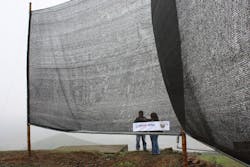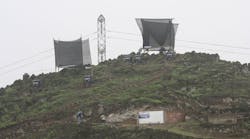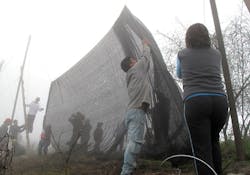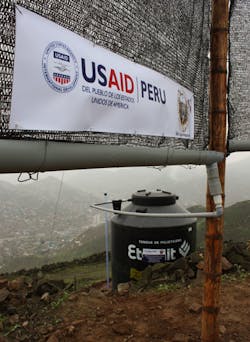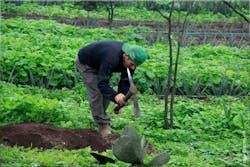Peru's Fog Catcher Initiative Goes XL
Receiving less than 1cm of rain a year and with water resources under threat, Peru's capital city Lima has had to get creative at high altitudes where municipal water departments cannot build reservoirs. Using enormous sheets of mesh to capture fog, up to 400,000 litres of fresh water could be provided to the region.
By Andrew Williams
Coastal Peru has six to eight months of daily fog, often described as an ‘ocean in the sky'. As a result, an ambitious project to install 1,000 innovative ‘fog catcher' devices in the desert region to the south of Lima, Peru is now well underway. When complete, the organisers hope that the scheme will help to provide up to 400,000 litres of fresh water per day to poverty stricken families throughout the arid region
The initiative is run by the Peruvians Without Water (Peruanos Sin Agua) movement, a local grass roots organisation headed up by community leader Abel Cruz. This strives to provide access to water to thousands of citizens who do not have it, especially at higher altitudes where municipal water departments have not been able to build reservoirs or tanks.
During February, the organisation installed the first three fog catcher systems at the Humano Villa Lourdes Ecologica settlement, a poor neighbourhood in the Villa Maria del Triunfo district of southern Lima. Eventually, the plan is to install between 100 and 200 systems throughout the community, with the ultimate objective being to set up 1,000 fog catchers, together capable of capturing between 200,000 and 400,000 litres of water per day.
The process
Fog collectors are typically composed of 4x10 metre or 4x8 metre rectangular sails supported between two vertical poles and constructed using Raschel mesh - the shade cloth you might often see in plant nurseries. When windblown fog passes through the collectors, fog droplets accumulate on the mesh and water drips into a gutter set below the mesh - where it is collected in a storage tank for later use in irrigation and other applications.
Although the group began working with fog catchers across different neighbourhoods of Lima as far back as 2010, it only secured the funding for a larger project in the Los Tunales area, located in the district of Villa Maria del Triunfo, in 2012.
The funding, which consisted of a small grant for US$21,233 from the USAID Peru Development Assistance Fund Program, paid for the installation of some twenty water catchment devices. These were equipped with integrated filters and storage tanks - along with two water storage reservoirs - on Cerro Nueva Esperanza mountain top in Villa Maria del Triunfo between April and September 2012. As Michael Karbeling, Peru, Paraguay and South America Regional Programs Desk Officer - Office of Latin American Affairs at USAID, explains, the installation provided water to the 75 families belonging to the Asociación Agroindustrial Llanavilla (ASALL) agricultural association. Longer-term use of the devices is "expected to produce data revealing efficiency and cost-effectiveness for use in future planning and expansion".
In Karbeling's view, the technique is particularly useful in the local climate because coastal Peru has six to eight months of daily fog - which he describes as almost another ‘ocean in the sky.'
"For a family without water, it can be relatively easy to make water by using cheap nursery polyethylene mesh to capture the fog and condense its water content. No matter how you put up the mesh -- for example, as a roof or as a pile on top of plastic -- it will condense and then the water can be diverted to tanks or reservoirs. No matter the platform, condensation happens," he says.
Karbeling reveals that the majority of the fog catchers used by Peruvians Without Water are rectangular in shape -- typically 4 x 8 metres -- and are normally placed between one and two metres above the ground, usually supported by bamboo poles, wire and some form of halved six inch PVC guttering at the bottom to catch the water.
"The use of this platform has remained the same over the years - with German NGOs being the first to install them 14 years ago. That said, there is more that can be done in designing fog catchers for maximum efficiency, such as employing double or triple mesh, and using different shapes, such as a diamond or an inverted bell. Also, some type of sand filter can be used to remove dust from the water. In general, the captured water is used to grow crops, care for animals and help with cleaning tasks," he adds.
Urban Communities Initiative
As a result of ongoing budget restrictions, Karbeling says that USAID Peru does not currently plan to provide any further investment in the initiative.
However, from a technical perspective, he stresses that USAID does believe that fog catcher systems remain a "worthwhile investment" and says that the organisation would be pleased to see other organisations undertake more research and provide more structures for low-income families lacking sufficient supplies of water.
"In particular, there are several areas around Lima and in other cities of Peru where this would serve as an appropriate technology for providing low-cost, sustainable access to water too," he adds.
Another organisation that has risen to the challenge of expanding the use of fog catcher systems in Peru is the University of Washington, which has set up the Informal Urban Communities Initiative (IUCI) - a research and education program based in Lomas de Zapallal (LdZ), a slum in northern Lima.
According to IUCI Co-Director Ben Spencer, assistant professor at the University of Washington, the project team will also benefit from the technical input of Abel Cruz on a planned ‘Fog Water Farms' project in LdZ this summer - which will make use of new fog collection materials developed during a pilot fog collection project (see box out).
"Fog collection is well suited to communities and sites where fog is abundant and other water resources are not readily available at a reasonable cost," says Spencer.
"Lima receives less than 1cm of rain a year and its water resources are under threat from a combination of melting glaciers, brought on by climate change, and urban expansion," he adds.
According to Spencer, many of Lima's poorer communities are forced to pay for expensive trucked in water - which can often cost up to twelve times more than the price of municipal supplies.
However, in spite of the lack of precipitation, fog is present in Lima for between six and nine months each year, making fog collection a viable alternative point of use water resource - especially during fog season.
"If Peru's glaciers continue to melt, Lima's water resources will become increasingly scarce and, as the city's impoverished populations continue to grow, water supplies will likely become increasingly unreliable and the price of trucked water will likely rise.
"The economic argument for fog collection in Lima's poorest urban communities may become increasingly convincing," adds Spencer.
Looking ahead, Spencer hopes that the Informal Urban Communities Initiative fog collection project - as well as the experimental materials the team is testing as part of it - will help to improve the fog collection yields of typical fog collectors and make the technology a "more viable and economical alternative water resource".
Operational challenges
Although he believes that such systems possess a good deal of promise, he also points out that a number of technological, financial and operational challenges remain before similar systems can be rolled out across Peru, as well as other water scarce areas in Latin America. In particular, he says that an increase in the efficiency of fog collectors, alongside a reduction in their cost and the establishment of policies and funds that support the implementation and maintenance of fog collection projects will help fog collection "gain a broader foothold as an alternative water resource in places with abundant fog". He also says it is essential that a number of pre-requisites need to be met in order to make fog collection projects a viable proposition.
These include the "consistent presence" of fog - and the right topography to intercept it - as well as a lack of other affordable water resources and adequate levels of community buy-in.
"If implemented on a broader scale, fog collection could form serve as one of a combination of technologies that contribute to increased water security," IUCI's Spencer adds.
"Fog collection is unlikely to solve all of Lima's water issues. However, it could serve as one of many strategies to provide water to the city - and in particular to the city's poorest communities," he concludes.
- Andrew Williams is a freelance contributor to WWi magazine. Email: [email protected]
Creating Foggy Spaces
When the team at the University of Washington were developing their fog collection technology they were unable to make use of the foggy climate prevalent on the hillsides and slopes of Lima. Instead, they used fog generated by a water pump at 1000 psi and ultra-fine nozzles - an approach that has been used to cool a campus based greenhouse for several decades.
"When Ben and Susan Bolton [the other Co-Director of the IUCI project] wanted to test the fog-catcher that they were working on, they naturally thought of me and the system we use," says Doug Ewing, who spent more than 30 years running and managing the New Botany Greenhouse at the University of Washington.
Because the team needed to run tests at times other than when the greenhouse needed cooling, Ewing provided a space outside the greenhouse and also helped with the design and erection of a hoop house covered in poly film.
"They used the same type of nozzle I use, but the water was supplied through an electric pressure washer running at 1000 psi. They had an exhaust fan at one end of the structure and the fog nozzles at the intake end," adds Ewing.
More Water & WasteWater International Archives Issue Articles
